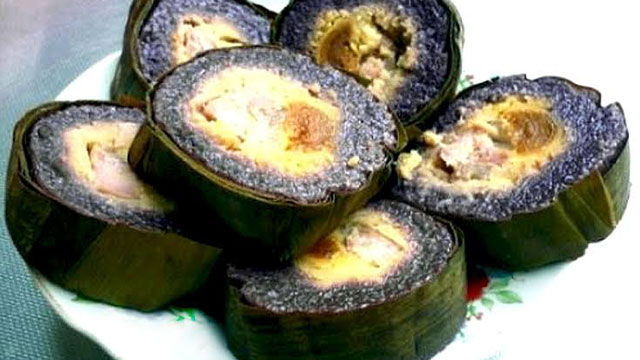Banh chung is a traditional cake indispensable in Vietnamese holidays. And in each region, people create different types of banh chung. Thai people are no exception, every day when the east wind blows, they rush to pack banh chung. But the Thai cake is the most delicious and different kind of black chung cake.
Muong Lo black banh chung has a different shape from plain plain banh chung. The elders recounted that because they wanted to connect the two Thai ethnic groups with the Kho Mu, they created this cake. The two cakes are like two hands facing each other to form a meaningful banh chung.
Glutinous rice must be a precious pearl in Tu Le. The leaves are green and the veins are cut off for easy wrapping. The filling still includes green beans and bacon, but the sticky part is added with black sesame. This is also the ingredient that makes black banh chung hard to resist.
In the process of dyeing the glutinous rice grain black, people use the charcoal of the nac tree. Mix thoroughly by hand until you rub it hard, but the glutinous rice grain does not fade, then the coloring is considered complete. Then, sitting together all night watching the pot of bread, people seem to forget the fatigue of the day and the season. Each pair of cakes, after being picked out, are hung up high to drain and not be moldy.
Enjoying Banh Chung is a blend of the aromatic plasticity of glutinous rice, the fatty taste of meat, green beans and black sesame, and the rustic taste of water and dong leaves that makes the cake linger on the tip of the tongue of the eater. .
Muong Lo black banh chung exists from generation to generation. Thai people not only consider banh chung as a dish but also as a gift to express gratitude to their predecessors. But it is not an exaggeration to say that on New Year’s Day, eating a piece of black Chung cake is like swallowing the whole Northwest sky in your heart.
Source: Collected internet.
Eight UNESCO world heritage sites stretch across Vietnam. Each place offers interesting perspectives on local life and majestic natural beauty. The Imperial Citadel and Hue mausoleums take you back to the Nguyen Dynasty full of ups and downs. Hoi An ancient town was once a bustling meeting point for ships and traders around the world. Throughout other provinces and cities, you will encounter ancient relics, poetic scenes, and vivid pieces that create the picture of Vietnamese heritage.
Vietnam has an area of 331,212 km², a land border of 4,639 km, a coastline of 3,260 km, and shares a maritime border with Thailand through the Gulf of Thailand and with China, the Philippines, Indonesia, Brunei, Malaysia through the East Sea. Vietnam claims sovereignty over two disputed geographical entities in the East Sea, the Hoang Sa archipelagos (which has lost control in reality) and Truong Sa
It's the economy of a developing country. From a poor and populous country, Vietnam has gradually recovered and developed after the devastation of war, the loss of financial aid from the former socialist bloc, and the weakness of its economy. concentrated economy. After 1986, with the Doi Moi Policy, Vietnam's economy made great progress and achieved an average economic growth rate of about 9% annually from 1993 to 1997. GDP growth was 8.5% in 1997, it decreased to 4% in 1998 due to the impact of the 1997 Asian economic crisis, and increased to 4.8% in 1999...
Vietnamese culture is one of the oldest cultures in the Pacific region. Although located next to two major cultures, Chinese and Indian culture, Vietnam still preserves many of its own cultural features, expressed in many aspects such as traditional customs that still exist today. Nowadays, Vietnamese people's life and folk literature are rich and unique. It can be said that Vietnamese culture is a special blend of many ancient cultures along with the indigenous culture of the Vietnamese people. In addition to the greatest influence of China, there is also the influence of Indian and Cham culture. , and later the great influence of Western culture (France, Russia, America).
